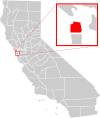Western Addition, San Francisco
37°46′57″N 122°25′42″W / 37.78250°N 122.42833°W
Western Addition | ||
|---|---|---|
State Senator Scott Wiener (D)[1] | | |
| • U. S. Rep. | Nancy Pelosi (D)[2] | |
| Area | ||
| • Total | 0.463 sq mi (1.20 km2) | |
| • Land | 0.463 sq mi (1.20 km2) | |
| Population (2008)[3] | ||
| • Total | 12,934 | |
| • Density | 27,919/sq mi (10,780/km2) | |
| ZIP Code | 94102, 94109, 94115, 94117 | |
| Area codes | 415/628 | |
| [3] | ||
The Western Addition is a district in San Francisco, California, United States.
Location
The Western Addition is located between
Today, the term Western Addition is generally used in two ways: to denote either the development's original geographic area or the eastern portion of the neighborhood (also called the
Those who use the term in the former sense generally consider its boundaries to be Van Ness Avenue on the east, Masonic on the west, California Street on the north, and Fell or Oak Street on the south. From there, it is usually divided into smaller neighborhoods such as
The San Francisco Association of Realtors defines the term more closely to the latter sense, treating it as "District 6D" (not to be confused with Board of Supervisors districts; much of the Western Addition is in supervisors District 5), bounded by Geary Boulevard in the north, McAllister and Fulton streets, and Golden Gate Avenue on the south, Van Ness Avenue in the east, and Divisadero Street on the west. By this definition, the Western Addition is roughly synonymous with the Fillmore and Cathedral Hill neighborhoods.[4]
History
Historically, the Western Addition was first
After the
Since the early 1990s, the Western Addition has undergone significant gentrification.[10][11]
Government and infrastructure
The San Francisco Police Department Northern Station serves the Western Addition.[12]
Notable buildings
- Building at 1840–1842 Eddy Street, 1840–1842 Eddy Street. Built in 1875, a residential house; listed as a California Historical Landmark, and a National Register of Historic Places listed place.[13][14]
- Building at 1813–1813B Sutter Street. Built in 1876, a rental house and commercial building; listed as a California Historical Landmark, and a National Register of Historic Places listed place.[15][16]
- Building at 1735–1737 Webster Street, 1735–1737 Webster Street. Built between 1876 and 1885; listed as a California Historical Landmark, and a National Register of Historic Places listed place.[17][18]
- Bush Street–Cottage Row Historic District, 2101–2125 Bush Street, 1–6 Cottage Row, and 1940–1948 Sutter Street. Comprising 20 historical residences, a walkway and a small park; listed as a San Francisco Designated Landmark, and a National Register of Historic Places listed place.[19][20][21]
- Goodman Building, 1117 Geary Blvd. Built around 1860, residential hotel and commercial building, formerly an artists coop building.[22]
- Japanese YWCA/Issei Women’s Building, 1830 Sutter Street. Because Japanese women were barred from using the main San Francisco YWCA, this was founded by Issei Japanese women in 1912; listed as a San Francisco Designated Landmark.[23]
- San Francisco Designated Landmark, a California Historical Landmark, and a National Register of Historic Places listed place.[24]
See also
- Bethel African Methodist Episcopal Church (San Francisco, California)
- Fillmore District
References
- ^ a b "Statewide Database". UC Regents. Retrieved December 8, 2014.
- ^ "California's 11th Congressional District - Representatives & District Map". Civic Impulse, LLC.
- ^ a b c "Western Addition neighborhood in San Francisco, California (CA), 94102, 94109, 94115, 94117 subdivision profile - real estate, apartments, condos, homes, community, population, jobs, income, streets". www.city-data.com.
- ^ "propertiessanfrancisco.com - propertiessanfrancisco Resources and Information". www.propertiessanfrancisco.com.
- ISSN 1047-5192.
- ^ "Jerry Mandel (1960) | UC Berkeley Sociology Department". sociology.berkeley.edu. Retrieved 2019-11-11.
- ISSN 0362-4331. Retrieved 2019-11-11.
- ^ Gordon, Rachel (2005-08-05). "SAN FRANCISCO / Western Addition deadliest city area / 3rd slaying in 8 days prompts response from police, mayor". SFGate. Retrieved 2019-11-11.
- ^ Van Derbeken, Jaxon (1999-08-14). "Bloodshed in Alamo Square / Drug dealers, thugs plague picturesque S.F. neighborhood". SFGate. Retrieved 2019-11-11.
- ^ Cherney, Max (2015-02-08). "San Francisco: Where Violent Street Gangs and Silicon Valley Tech Bros Coexist". Vice. Retrieved 2019-11-11.
- ^ Blake, Shaquina (March 5, 2016). "In Their Words: Growing Up in Old Fillmore". Hoodline. Archived from the original on February 5, 2017.
- ^ "Northern Station." (Archive) San Francisco Police Department. Retrieved on September 1, 2013.
- ^ "Building at 1840–1842 Eddy Street". Office of Historic Preservation, California State Parks. Retrieved 2023-05-23.
- ^ "National Register of Historic Places Inventory/Nomination: Building at 1840--1842 Eddy Street". National Park Service. Retrieved May 24, 2023. With accompanying pictures
- ^ "National Register of Historic Places Inventory/Nomination: Building at 1813--1813B Sutter Street". National Park Service. Retrieved May 24, 2023. With accompanying pictures
- ^ "Building at 1813–1813B Sutter Street". Office of Historic Preservation, California State Parks. Retrieved 2023-05-23.
- ^ "Building at 1735–1737 Webster Street". CA State Parks.
- ^ "National Register of Historic Places Inventory/Nomination: Building at 1735--1737 Webster Street". National Park Service. January 9, 1973. With accompanying photo from 1972
- ^ "Bush Street-Cottage Row Historic District". NPGallery, Digital Asset Management System.
- ^ "National Register #82000983: Bush Street Cottage Row Historic District in San Francisco, California". noehill.com. Retrieved 2023-05-24.
- ^ "San Francisco Historic District: Bush Street-Cottage Row". noehill.com. Retrieved 2023-05-24.
- ^ Writer, Maitland Zane, Chronicle Staff (1996-06-22). "Artists' Colony Reblooms in S.F. / `Goodman 2' opens 13 years after old building closed". SFGate. Retrieved 2022-11-28.
{{cite web}}: CS1 maint: multiple names: authors list (link) - ^ "San Francisco Landmark #291: Japanese YWCA/Issei Women's Building". noehill.com. Retrieved 2023-05-24.
- ^ Graham, Tom (2006-04-16). "The Great Quake: 1906-2006 / A city walker steps back 100 years". SFGate. Retrieved 2022-11-28.
External links
Western Addition, San Francisco.
 San_Francisco/Western Addition travel guide from Wikivoyage
San_Francisco/Western Addition travel guide from Wikivoyage

